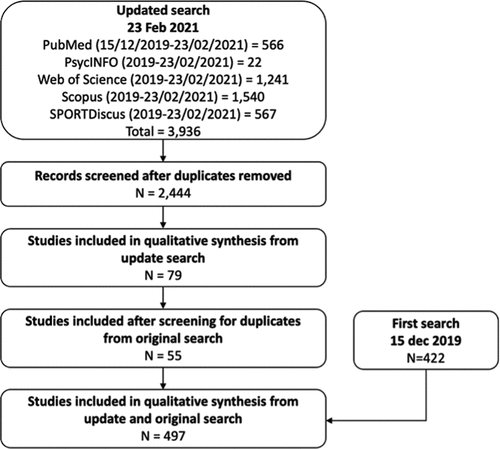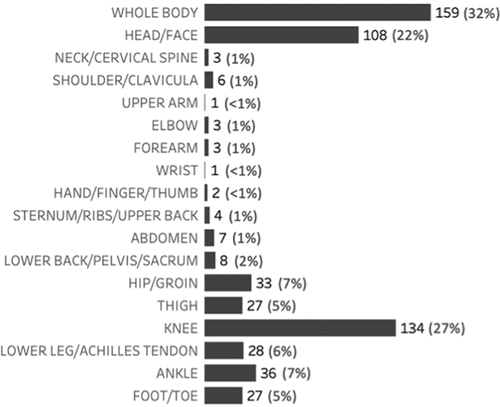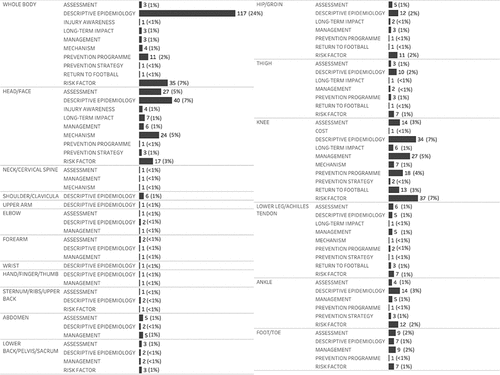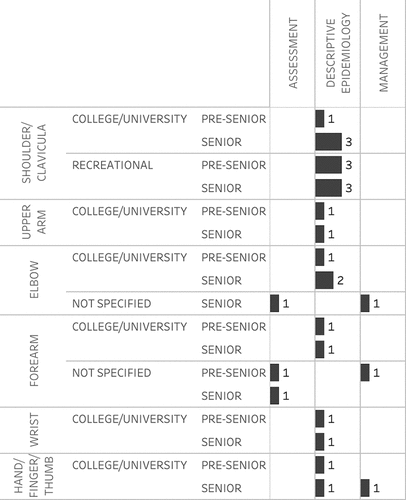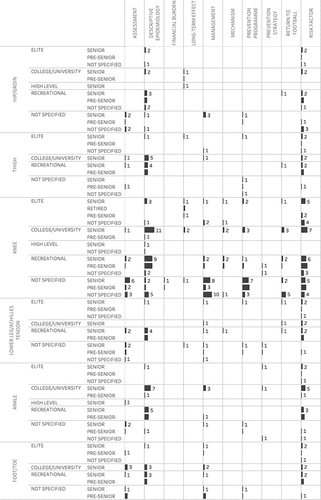ABSTRACT
This review aimed, as part of a larger FIFA project aiming to steer women’s football research, to scope literature on any level of competitive football for women, to understand the current quantity of research on women’s football injuries. The study reviewed all injury-related papers scoped by a recent scoping review mapping all published women's football research with an updated search performed on 23 February 2021. Eligibility criteria assessment followed the recent scoping review with injury-specific research focus. A total of 497 studies were scoped. Most studies contained an epidemiological (N = 226; 45%) or risk factors assessment (N = 105; 21%). Less assessed areas included financial burden (N = 1; <1%) and injury awareness (N = 5; 1%). 159 studies (32%) assessed injuries of the whole body. The most common single location assessed in the literature was the knee (N = 134, 27%), followed by head/face (N =108, 22%). These numbers were, however, substantially lowered, when subdivided by playing level and age-group. The volume of research focuses especially on descriptive research and specific body locations (head/face and knee). Although information can be taken from studies in other sports, more football-specific studies to support management and prevention of injuries are warranted.
Introduction
Women’s football (soccer) is currently in a boom of popularity and is one of the most popular sports for women and girls today (UEFA, Citation2017). Globally, there are more than 13 million playing organized football and there are 945,068 female adult players officially registered with the Fédération Internationale de Football Association (FIFA; Fédération Internationale de Football Association, Citation2014).
In parallel with an increasing rise in participation and recognition from international governing bodies (Fédération Internationale de Football Association, Citation2014, Citation2016, Citation2020; UEFA, Citation2016,Citation2017), women’s football has also received increased attention from sports researchers around the world, though far from comparable to their male counterparts (Pfister, ; Okholm Kryger et al., Citation2021). Injury prevention and the management of injuries i.e. rehabilitation are particularly hot topics in football and sports in general. However, while injuries in men’s football have been widely researched (Kirkendall, Citation2020), it is unlikely that applying what we know from men’s football to the women’s game will provide us an accurate and comprehensive understanding of the women’s side of the story, as football injuries, and injury burden, differ between male and female players (Larruskain et al., Citation2018; Waldén et al., Citation2018; Werner et al., Citation2019). In addition, female-biased conditions believed to impact injury risk exist including hormonal fluctuations during the menstrual cycle and disordered eating (Martin et al., Citation2021; Waldén et al., Citation2018).
A systematic approach to implement the best of research- and practice-based evidence to make quality decisions has been proposed for sports medicine decision making in the practical setting (Ardern et al., Citation2019b; Finch, Citation2006). The three-step approach is suggested: (1) to systematically review published literature, including its quality, (2) to combine the published evidence with quality clinical evidence, and (3) to consider its feasibility of use in the given practical setting (Ardern et al.,Citation2019b). An understanding of current research focus and gaps in the literature is therefore essential.
This study is a follow-up from a larger scoping review performed on all literature published on all aspects of women’s football (Okholm Kryger et al., Citation2021). Injury-related literature in particular showed a yearly increase in research outputs with a total of 442 papers identified (Okholm Kryger et al., Citation2021). A further sub-categorization of this injury-related literature will help guide researchers to which areas are lacking attention to allow for evidence-based practice when assessing, managing, preventing and educating around injuries in women’s football at all levels and in all age groups. Therefore, the aim of this study was to scope the available peer-reviewed literature published in English,French, German and Spanish (i.e., the official FIFA languages) on any level of competitive football for women, to understand the current quantity of research on women’s football injuries.
Methods
The protocol for this scoping review was pre-registered on Open Science Framework (osf.io/gp7fb). The study followed the Preferred Reporting Items for Systematic reviews and Meta-Analyses extension for Scoping Reviews (PRISMA-ScR) Checklist (Tricco Tricco et al.,Citation2018) as well as the recommended best practise guidelines for scoping reviews by Levac et al. (Citation2010)
The search strategy and study selection methodology are previously described in the larger scoping review performed on all literature published on women’s football (Okholm Kryger et al., Citation2021). The following keywords were therefore applied (football OR soccer) AND (female* OR woman OR women OR ladies OR lady). Five relevant databases were selected through researcher discussion and searched (PubMed (1966–2019), PsycINFO (1967–- 2019), Web of Science (1900–2019), Scopus (1788–2019), SPORTDiscus (1892–2019)). The first search was conducted on 15 December 2019 and was updated to 23 February 2021 for this study following the original procedure (Okholm Kryger et al., Citation2021) but soley scoping for injury-related articles.
Data extraction
To standardize level of play and age, grouping of descriptions was applied (). The extracted articles on injury-specific data were grouped based on injury location using the Fuller et al. (Citation2006) consensus statement on injury definitions in football. Injury-related studies were further subcategorized by the research topic (). The topics discovered were further sub-categorized as descriptive, proactive and reactive research defined as (1) “descriptive” research establishes how often injuries occur, (2) reactive research focuses on handling the injuries that have occurred, (3) proactive research focuses on aiding understanding of how, why and in which situational circumstances certain injuries occur and strategies targeting the mitigation of injury occurrence ().
Table 1. Explanation of level of play grouping applied.
Table 2. Explanation of age grouping applied.
Table 3. Operational definitions of the terms used to classify the injury research topic.
Data charting
The data were compiled in a single Microsoft Excel spreadsheet (Microsoft Corporation, Redmond, WA). Data were charted in Tableau (Mountain View, Seattle, WA) using bar charts for categorical data (injury location, research topic, playing level and age group). Categorical data of injury location, research topic, playing level and age group were also assessed using multilevel content evaluation, which was charted using bar charts. For multilevel content evaluation, it must be noted that studies may have assessed multiple injury locations, topics, playing levels and/or age groups. For example, if a study investigated a knee prevention programme and its relationship with injury mechanisms in elite and recreational players, it was assigned to both elite and recreational playing level as well as both mechanism and prevention programme topics. The study would in this case appear under both elite and recreational playing level for both mechanism and prevention programme topic and hence not represent to total number of studies conducted in the literature.
Results
The updated online search of the five mentioned databases yielded 3,936 results (). After removal of duplicates using Mendeley, 2,444 titles and abstracts were screened. A total of 79 articles remained after the title and abstract screening. After checking for duplicates from the original search, a total of 55 new papers were included. These were added to the 442 originally scoped articles, summing up to a total of 497 articles scoped for this study (; Appendix 1).
Injury topic focus
From all 497 injury-focused studies, the topic, using the definitions detailed in , revealed the majority of studies contained descriptive epidemiological assessment (N = 226, ) followed by risk factors (N = 105, ). Less-assessed areas included cost (N = 1, ) and injury awareness (N = 5, ). In a chronological injury event order, the mechanism of injury was addressed in 37 studies, assessment of injury in 74 studies and the management of the injury in 68 studies, whilst the return to play was addressed in 16 studies. Methods of injury prevention were addressed 31 times using a training programme and ten times using other proposed strategies.
Injury location focus
From all injury-focused studies, the location in accordance with the Fuller et al. (Citation2006) consensus statement on injury definitions revealed 159 studies (32%) reviewing injuries of the whole body (). These studies commonly presented descriptive epidemiological data (). The most common single location assessed in the literature was the knee (N = 134, 27%), of which, 89 (18%) included the word anterior cruciate ligament injuries or ACL in their abstracts. Studies with a knee injury focus varied in themes (). The second most common single location involved the head/face (N = 108, 22%), of which, 96 (19%) studies included the word concussion in their abstract.
Injury location focus by topic, playing level and age group
Data were further broken down to identify how research focus on the different injury locations and topics were evaluated within population-specific metrics (playing level and age group).
A large spread was seen for whole body assessments, where descriptive epidemiological research predominantly focused on recreational pre-seniors (N = 28, ) and seniors (N = 25, ), although a high proportion of studies did not declare the playing level and age group assessed within their abstract or title ().
Figure 6a. Head/face, neck and core focused research divided by research topic, playing level and age group.

The upper limb was the least assessed body region with no more than three studies covering a topic within a specific injury location for a given playing level and age group (). These involved descriptive epidemiology of shoulder injuries in senior college and senior and pre-senior recreational players (). Multiple upper limb areas have not yet been covered by research ().
The head/face injuries were predominantly studied in non-elite populations () with the most studies conducted on descriptive epidemiology in senior college/university players (N = 13) and recreational senior (N = 11) and pre-senior populations (N = 11, ). The neck/cervical spine and core region injuries were not assessed by more than three studies within the given topic, playing level and age group (). Multiple neck/cervical spine and trunk areas have not yet been covered by research ().
The lower limb was the most assessed body region with the knee region demonstrating a broad spread in research topics covered for the different playing levels and age groups (). On the contrary, areas not yet covered by research include injury mechanism of non-knee lower limb injuries and limited research is currently available on most non-knee related injury regions of the lower limb, when divided by playing levels and age groups ().
Discussion
This study aimed to scope the available peer-reviewed, FIFA language literature on women’s football injuries. The current volume of research proved to be limited with focus given mainly to a few specific research topics and body locations. Yet tendencies showed attention given to both elite and recreational players within those research topics and body locations. Disability players have, however, not been a common population featured in research studies.
Descriptive research
From the 497 studies in this scoping review, nearly half (N = 226; 45%) of all studies were related to descriptive epidemiology. These descriptive epidemiological studies predominantly focused on the whole body (N = 117; 52%), head or face (N = 40; 18%) and knee (N = 34; 15%). On the contrary, only 37 of all identified studies (7%) were found to assess the mechanism of injuries, which, again, predominantly focused on the whole body (N = 4; 11%), head or face (N = 24; 65%) and knee (N = 7; 19%). An attempt has therefore been made by researchers to understand “how many” injuries occur. Systematic reviews on injury epidemiology in women’s football exist (Alahmad et al., Citation2020), however, it is debatable how accurately a systematic review of current literature reflects current tendencies in football due to the rapid changes to the game. A large impacting factor to consider when reviewing injury describing research is the rapid physical and tactical development occurring with the professionalization of the women’s game (FIFA, Citation2019). Hence, caution with the interpretation of older research is needed.
Reactive and proactive research
Reactive research was covered by 67 injury assessment studies (15%), 60 injury management studies (14%), 15 return to play studies (3%), 14 long-term impact studies (3%) and a single cost focused study (<1%). When these are further broken down by body region, playing level and age group, the numbers drastically decreased, demonstrated by the most commonly researched reactive research injury topic “injury assessment” maximally reaching a cover of five studies. Similarly, proactive research demonstrated limited studies available in the literature with 88 studies exploring risk factors (20%), three studies on injury awareness (<1%) and 25 and 8 studies on injury programmes and strategies, respectively (6% and 2%). When these, again, are further broken down by body region, playing level and age group, the numbers drastically decreased the most commonly researched proactive strategy topic “risk factors” was maximally covered by seven studies for knee injuries in pre-senior recreational players. A recent meta-analysis systematically reviewed the efficacy of preventive programmes on injury incidence in any women’s football code (e.g., rugby, football and American football; Crossley et al., Citation2020). However, the authors combined studies from different competitive levels (community to professional), age (from under 13 to adults), football codes, and sex (mixed in some studies). This review also identified a high risk of bias in all but one of the included studies. Caution should be made when drawing conclusions by merging different sports but equally when merging playing levels, age groups, and ageing studies which are quickly outdated due to the vast development of women’s football. The present scoping review therefore suggests that more primary research is needed before systematic reviews and meta-analysis can attempt to summarize on optimal injury management strategies.
Body location focus
A large discrepancy was seen in research attention for different body locations. The head and knee were the most commonly researched body parts, whilst recent epidemiological research on elite seniors identified the anterior thigh (Mayhew Tricco et al., Citation2018) as the most common injury location. Epidemiological research on elite and non-elite pre-seniors has identified the ankle as the most common injury location for both recreational and elites (Le Gall et al., Citation2008; Martín-San Agustín et al., Citation2021; Söderman et al., Citation2001). A limited amount of research is therefore available for medical staff to make a quality decision for sports medicine related practices on the most commonly injured locations (Ardern et al., Citation2019b, Citation2019a). It should, of course, be acknowledged that some generic research can be used across sports, though sports specificity is needed in areas such as injury mechanism or return to play. The increased research focus is, instead, likely due to the time-loss caused and risks of not returning to sport associated with head (Stone et al., Citation2017; Vedung et al., Citation2020) and knee (Fältström et al., Citation2016; Roos et al., Citation1995; Waldén et al., Citation2011) injuries in women’s football. Yet despite the research focus, injury rates remain high and in particular, higher than their male counterparts (Mayhew Gupta et al., Citation2020; Kontos et al., Citation2020; Tricco et al., Citation2018; Vedung et al., Citation2020), indicating that a better understanding and hence more research is still needed – even in areas receiving higher levels of attention (Lislevand et al., Citation2014). Concussion reactive and proactive research are also lacking for all sports as new and more sensitive assessment methods are being implemented, treatment practice is changing and the long-term impacts are being reviewed (Asken et al., Citation2018; Jackson & Starling, Citation2019; McCrory et al., Citation2013, Citation2017; Nordström et al., Citation2014; Patricios et al., Citation2017).
Strengths and limitations
Our scoping review followed the PRISMA-SR Checklist (Tricco Tricco et al., Citation2018) as well as the recommended best practice guidelines for scoping reviews by Levac et al. (Citation2010). In our study, we searched five databases and scoped for peer-reviewed studies written in four languages. Yet, it must be acknowledged that studies not retrievable from these databases are not included in this study. Additionally, studies not identifying the sport and/or the sex of the athletes were excluded during the screening process. A large proportion of studies also lacked clarification on playing level and age group assessed in the study. The authors manually classified the studies into topics, which although screened by two independent reviewers may have introduced bias. Finally, it was not possible to identify the geographical origin of the papers published and caution should be made when generalizing e.g., epidemiological trends from one geographical location to another due to known factors likely to alter injury rates such as surfaces conditions (Fuller et al., Citation2007a, Citation2007b), match schedules (Huggins et al., Citation2020), and training load/styles (Huggins et al., Citation2020).
Conclusion
The volume of research proved to be heterogeneous and limited with focus given especially to descriptive research and the head/face and knee locations. Additionally, cautions should be made when reading or systematically reviewing literature as it quickly outdates due to the vast development of women’s football. Studies to enhance the understanding and application of preventive or treatment strategies for injuries are lacking, making it difficult for medical staff to make evidence-informed decisions for injury prevention and management. Our scoping review therefore suggests that research groups and practitioner scholars focus research efforts on understanding injury mechanisms, risk factors, inform design and execution of preventive strategies and guide the return to play process of injuries in women’s football at all levels and in all age groups.
Key Points
Female football injury research is predominantly composed of epidemiological research.
Discrepancies in research focus is seen between body regions – with knee and head/face attracting the most attention.
Less research focuses on management of commonly faced injuries dealt with in day-to-day practice – e.g., thigh strains and ankle sprains.
It is challenging for clinicians to evidence base injury prevention and management strategies of certain injury types due to lack of research.
Supplemental Material
Download MS Excel (394.4 KB)Disclosure statement
No potential conflict of interest was reported by the author(s).
Supplementary material
Supplemental data for this article can be accessed here
Additional information
Funding
References
- Alahmad, T. A., Kearney, P., & Cahalan, R. (2020). Injury in elite women’s soccer: A systematic review. The Physician and Sportsmedicine, 48(3), 259–265. https://doi.org/10.1080/00913847.2020.1720548
- Ardern, C. L., Dupont, G., Impellizzeri, F. M., O’Driscoll, G., Reurink, G., Lewin, C., & McCall, A. (2019a). Infographic. Unravelling confusion in sports medicine and science practice: A systematic approach. British Journal of Sports Medicine, 53(13), 835–836. https://doi.org/10.1136/bjsports-2018-100302
- Ardern, C. L., Dupont, G., Impellizzeri, F. M., O’Driscoll, G., Reurink, G., Lewin, C., & McCall, A. (2019b). Unravelling confusion in sports medicine and sports science practice: A systematic approach to using the best of research and practice-based evidence to make a quality decision. British Journal of Sports Medicine, 53(1), 50–56. https://doi.org/10.1136/bjsports-2016-097239
- Asken, B. M., Bauer, R. M., Guskiewicz, K. M., McCrea, M. A., Schmidt, J. D., Giza, C. C., Snyder, A. R., Houck, Z. M., Kontos, A. P., McAllister, T. W., Broglio, S. P., Clugston, J. R., Anderson, S., Bazarian, J., Brooks, A., Buckley, T., Chrisman, S., Collins, M., DiFiori, J., … Svoboda, S. (2018). Immediate removal from activity after sport-related concussion is associated with shorter clinical recovery and less severe symptoms in collegiate student-athletes. The American Journal of Sports Medicine, 46(6), 1465–1474. https://doi.org/10.1177/0363546518757984
- Crossley, K. M., Patterson, B. E., Culvenor, A. G., Bruder, A. M., Mosler, A. B., & Mentiplay, B. F. (2020). Making football safer for women: A systematic review and meta-analysis of injury prevention programmes in 11 773 female football (soccer) players. British Journal of Sports Medicine, 54(18), 1089–1098. https://doi.org/10.1136/bjsports-2019-101587
- Fältström, A., Hägglund, M., & Kvist, J. (2016). Factors associated with playing football after anterior cruciate ligament reconstruction in female football players. Scandinavian Journal of Medicine & Science in Sports, 26(11), 1343–1352. https://doi.org/10.1111/sms.12588
- Fédération Internationale de Football Association (2014) WOMEN’S FOOTBALL SURVEY. (Retrieved: 27 April 2020) From https://resources.fifa.com/image/upload/fifa-women-s-football-survey-2522649.pdf?cloudid=emtgxvp0ibnebltlvi3b
- Fédération Internationale de Football Association (2016) FIFA 2.0: THE VISION FOR THE FUTURE. (Retrieved: 27 April 2020) From https://www.sportanddev.org/sites/default/files/downloads/fifa_2.0._the_vision_for_the_future.pdf
- Fédération Internationale de Football Association (2020) FIFA forward football development programme.
- FIFA (2019) ‘Physical analysis of the FIFA women’s world cup Frnace 2019TM’, https://img.fifa.com/image/upload/zijqly4oednqa5gffgaz.pdf
- Finch, C. (2006). A new framework for research leading to sports injury prevention. Journal of Science and Medicine in Sport, 9(1–2), 3–9. discussion 10. https://doi.org/10.1016/j.jsams.2006.02.009
- Fuller, C. W., Dick, R. W., Corlette, J., & Schmalz, R. (2007a). Comparison of the incidence, nature and cause of injuries sustained on grass and new generation artificial turf by male and female football players. Part 1: Match injuries. British Journal of Sports Medicine, 41(Suppl 1), i20–26. https://doi.org/10.1136/bjsm.2007.037267
- Fuller, C. W., Dick, R. W., Corlette, J., & Schmalz, R. (2007b). Comparison of the incidence, nature and cause of injuries sustained on grass and new generation artificial turf by male and female football players. Part 2: Training injuries. British Journal of Sports Medicine, 41(Suppl 1), i27–32. https://doi.org/10.1136/bjsm.2007.037275
- Fuller, C. W., Ekstrand, J., Junge, A., Andersen, T. E., Bahr, R., Dvorak, J., H??gglund, M., McCrory, P., & Meeuwisse, W. H. (2006). Consensus statement on injury definitions and data collection procedures in studies of football (soccer) injuries. Clinical Journal of Sport Medicine, 16(2), 97–106. https://doi.org/10.1097/00042752-200603000-00003
- Gupta, A. S., Pierpoint, L. A., Comstock, R. D., & Saper, M. G. (2020). Sex-based differences in anterior cruciate ligament injuries among united states high school soccer players: an epidemiological study. Orthopaedic Journal of Sports Medicine, 8(5), 2325967120919178. https://doi.org/10.1177/2325967120919178
- Huggins, R., Curtis, R., Benjamin, C.L., Sekiguchi, Y., Wasserman, E., Klossner, D., Casa, D.J. (2020). Match congestion and training load influence injury risk in collegiate men’s and women’s soccer. British Journal of Sports Medicine, 54(Suppl1), A45. https://doi.org/10.1136/bjsports-2020-IOCAbstracts.104
- Jackson, W. T., & Starling, A. J. (2019). Concussion evaluation and management. The Medical Clinics of North America, 103(2), 251–261. https://doi.org/10.1016/j.mcna.2018.10.005
- Kirkendall, D. T. (2020). Evolution of soccer as a research topic. Progress in Cardiovascular Diseases, 63(6), 723–729. https://doi.org/10.1016/j.pcad.2020.06.011
- Kontos, A. P., Eagle, S. R., Putukian, M., Kirkendall, D., Chiampas, G., & Kaminski, T. (2020). Concussions in U.S. youth soccer players: Results from the U.S. soccer online concussion survey. Science and Medicine in Football, 4(2), 87–92. https://doi.org/10.1080/24733938.2020.1736327
- Larruskain, J., Lekue, J. A., Diaz, N., Odriozola, A., & Gil, S. M. (2018). A comparison of injuries in elite male and female football players: A five-season prospective study. Scandinavian Journal of Medicine & Science in Sports, 28(1), 237–245. https://doi.org/10.1111/sms.12860
- Le Gall, F., Carling, C., & Reilly, T. (2008). Injuries in young elite female soccer players: An 8-season prospective study. The American Journal of Sports Medicine, 36(2), 276–284. https://doi.org/10.1177/0363546507307866
- Levac, D., Colquhoun, H., & O’Brien, K. K. (2010). Scoping studies: Advancing the methodology. Implementation Science: IS, 5(1), 69. https://doi.org/10.1186/1748-5908-5-69
- Lislevand, M., Andersen, T. E., Junge, A., Dvorak, J., & Steffen, K. (2014). Injury surveillance during a 2-day national female youth football tournament in Kenya. British Journal of Sports Medicine, 48(11), 924–928. https://doi.org/10.1136/bjsports-2013-092307
- Martín-San Agustín, R., Medina-Mirapeix, F., Esteban-Catalán, A., Escriche-Escuder, A., Sánchez-Barbadora, M., & Benítez-Martínez, J. C. (2021). Epidemiology of injuries in first division Spanish women’s soccer players. International Journal of Environmental Research and Public Health, 18(6), 3009. https://doi.org/10.3390/ijerph18063009
- Martin, D., Timmins, K., Cowie, C., Alty, J., Mehta, R., Tang, A., Varley, I. (2021). Injury incidence across the menstrual cycle in international footballers. Frontiers in Sports and Active Living, 3. https://doi.org/10.3389/fspor.2021.616999
- McCrory, P., Meeuwisse, W.H, Aubry, M., Cantu, B., Dvorák, J., Echemendia, R.J., Engebretsen, L., Johnston, K., Kutcher, J.S., Raftery, M., Sills, A., Benson, B.W., Davis, G.A, Ellenbogen, R.G., Guskiewicz, K., Herring, S.A., Iverson, G.L., Jordan, B.D., Kissick, J., McCrea, M., McIntosh, A.S. (2013). Consensus statement on concussion in sport: The 4th international conference on concussion in sport held in Zurich, november 2012. British Journal of Sports Medicine, 47(5), 250–258. https://doi.org/10.1136/bjsports-2013-092313
- McCrory, P., Meeuwisse, W., Dvořák, J., Aubry, M., Bailes, J., Broglio, S., Cantu, R. C., Cassidy, D., Echemendia, R. J., Castellani, R. J., Davis, G. A., Ellenbogen, R., Emery, C., Engebretsen, L., Feddermann-Demont, N., Giza, C. C., Guskiewicz, K. M., Herring, S., Iverson, G. L., … Vos, P. E. (2017). Consensus statement on concussion in sport—the 5th international conference on concussion in sport held in Berlin, october 2016. British Journal of Sports Medicine, 51(11), 838–847. https://doi.org/10.1136/bjsports-2017-097699
- Nordström, A., Nordström, P., & Ekstrand, J. (2014). Sports-related concussion increases the risk of subsequent injury by about 50% in elite male football players. British Journal of Sports Medicine, 48(19), 1447–1450. https://doi.org/10.1136/bjsports-2013-093406
- Okholm Kryger, K., Wang, A., Mehta, R., Impellizzeri, F., Massey, A., McCall, A. (2021). Research on women’s football: A scoping review. Science and Medicine in Football, 1–10. https://doi.org/10.1080/24733938.2020.1868560
- Patricios, J., Fuller, G. W., Ellenbogen, R., Herring, S., Kutcher, J. S., Loosemore, M., Makdissi, M., McCrea, M., Putukian, M., & Schneider, K. J. (2017). What are the critical elements of sideline screening that can be used to establish the diagnosis of concussion? A systematic review. British Journal of Sports Medicine, 51(11), 888–894. https://doi.org/10.1136/bjsports-2016-097441
- Pfister, G. (2015). Assessing the sociology of sport: On women and football. International Review for the Sociology of Sport, 50(4–5), 563–569. https://doi.org/10.1177/1012690214566646
- Roos, H., Ornell, M., Gärdsell, P., Lohmander, L., & Lindstrand, A. (1995). Soccer after anterior cruciate ligament injury–an incompatible combination? A national survey of incidence and risk factors and a 7-year follow-up of 310 players. Acta Orthopaedica Scandinavica, 66(2), 107–112. https://doi.org/10.3109/17453679508995501
- Söderman, K., Adolphson, J., Lorentzon, R., Alfredson, H. (2001). Injuries in adolescent female players in European football: A prospective study over one outdoor soccer season. Scandinavian Journal of Medicine & Science in Sports, 11(5), 299–304. https://doi.org/10.1034/j.1600-0838.2001.110508.x
- Stone, S., Lee, B., Garrison, J. C., Blueitt, D., & Creed, K. (2017). Sex differences in time to return-to-play progression after sport-related concussion. Sports Health, 9(1), 41–44. https://doi.org/10.1177/1941738116672184
- Tricco, A. C., Lillie, E., Zarin, W., O'Brien, K.K, Colquhoun, H., Levac, D., Moher, D., Peters, M., Horsley, T., Weeks, L., Hempel, S., Akl, E.A., Chang, C., McGowan, J., Stewart, L., Hartling, L., Aldcroft, A., Wilson, M.G., Garritty, C., Lewin, S., Godfrey, C.M. (2018). PRISMA extension for scoping reviews (PRISMA-ScR): Checklist and explanation. Annals of Internal Medicine. American College of Physicians, 169(7), 467–473. https://doi.org/10.7326/M18-0850
- UEFA (2016) Women’s Football across the national associations 2015-2016. (Retrieved: 27 April 2020) From https://www.uefa.com/MultimediaFiles/Download/OfficialDocument/uefaorg/Women’sfootball/02/30/93/30/2309330_DOWNLOAD.pdf
- UEFA (2017) Women’s football across the national associations 2016/17. https://www.uefa.com/MultimediaFiles/Download/OfficialDocument/uefaorg/Women’sfootball/02/43/13/56/2431356_DOWNLOAD.pdf (Accessed: 27 April 2020)
- Vedung, F., Hänni, S., Tegner, Y., Johansson, J., & Marklund, N. (2020). Concussion incidence and recovery in Swedish elite soccer — Prolonged recovery in female players. Scandinavian Journal of Medicine & Science in Sports, 30(5), 947–957. https://doi.org/10.1111/sms.13644
- Waldén, M., Hägglund, M., Magnusson, H., & Ekstrand, J. (2011). Anterior cruciate ligament injury in elite football: A prospective three-cohort study. Knee Surgery, Sports Traumatology, Arthroscopy: Official Journal of the ESSKA, 19(1), 11–19. https://doi.org/10.1007/s00167-010-1170-9
- Waldén, M., Knudsen, M., Lundblad, M., Ekstrand, J., & H, M. (2018). The Female Player: Special Considerations. In: Musahl, V., Karlsson, J., Krutsch, W., Mandelbaum, B., Espregueira-Mendes, J., and d'Hooghe, P. (eds) Return to play in football. (pp. 929–940). https://doi.org/10.1007/978-3-662-55713-6_72
- Werner, J., Hägglund, M., Ekstrand, J., & Waldén, M. (2019). Hip and groin time-loss injuries decreased slightly but injury burden remained constant in men’s professional football: The 15-year prospective UEFA elite club injury study. British Journal of Sports Medicine, 53(9), 539–546. https://doi.org/10.1136/bjsports-2017-097796


